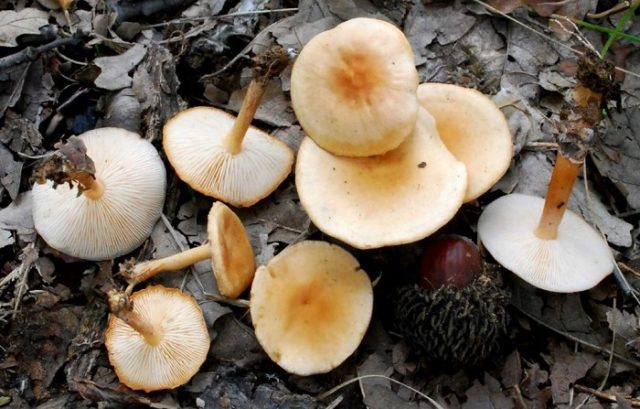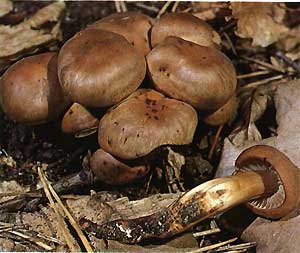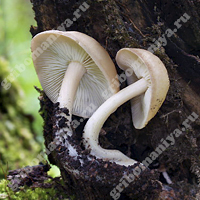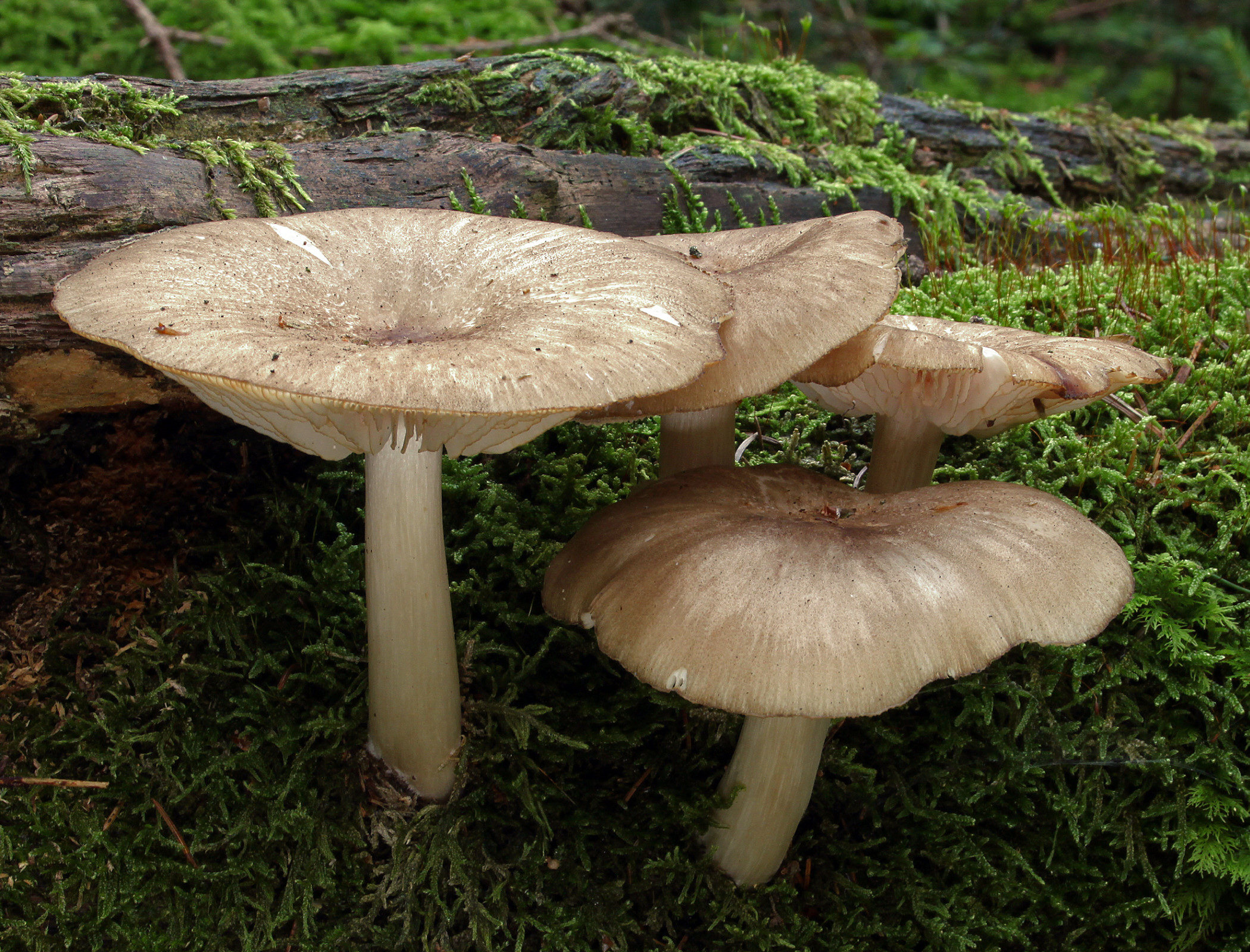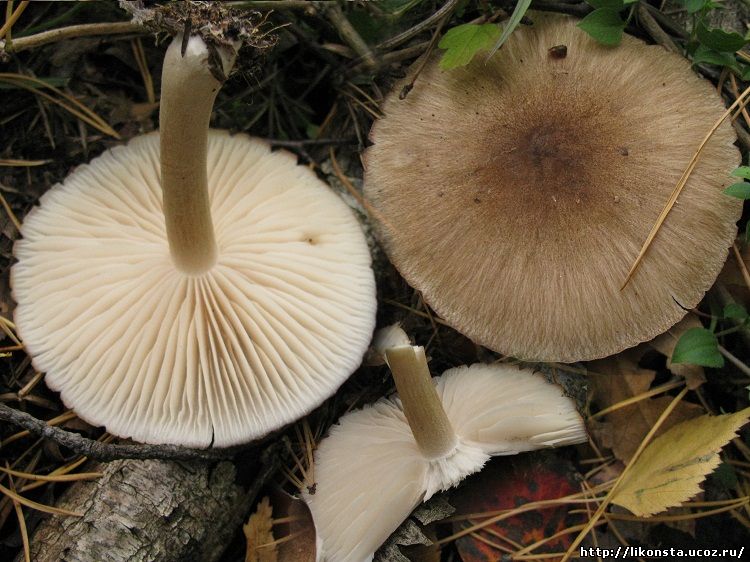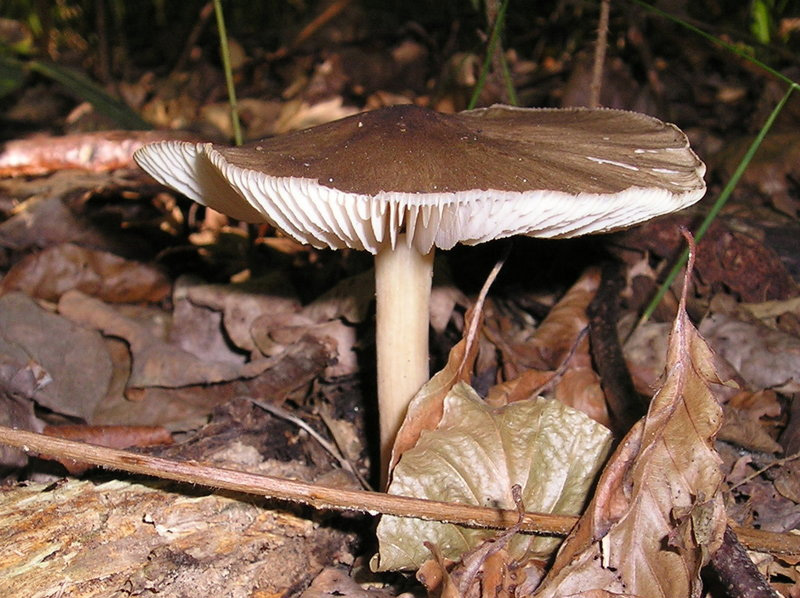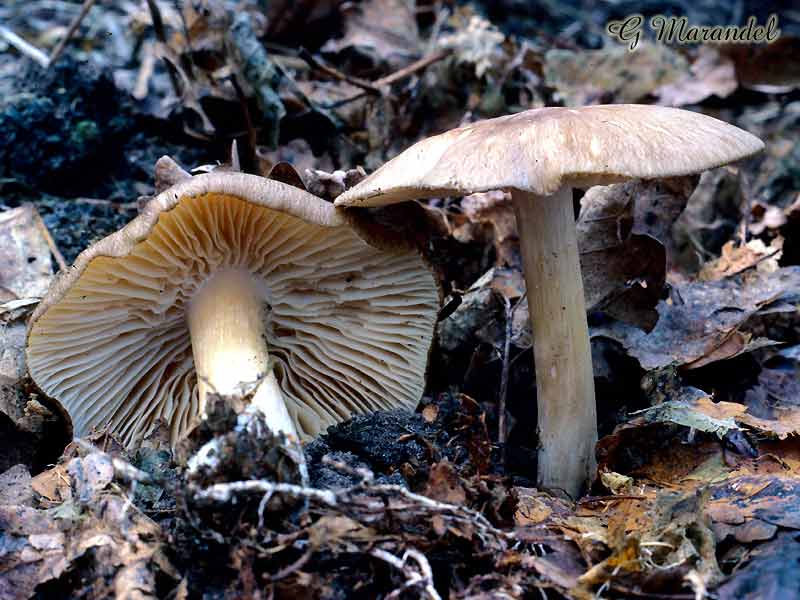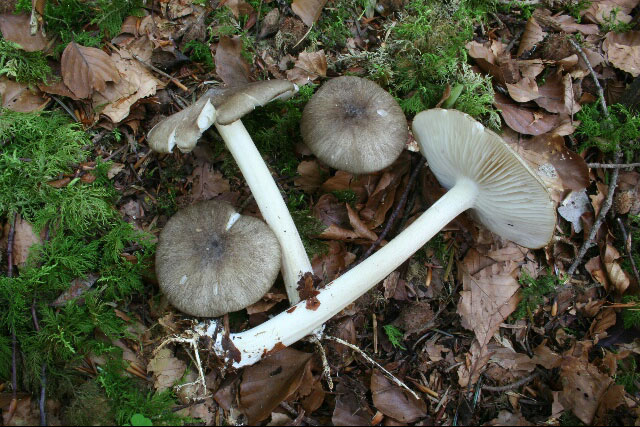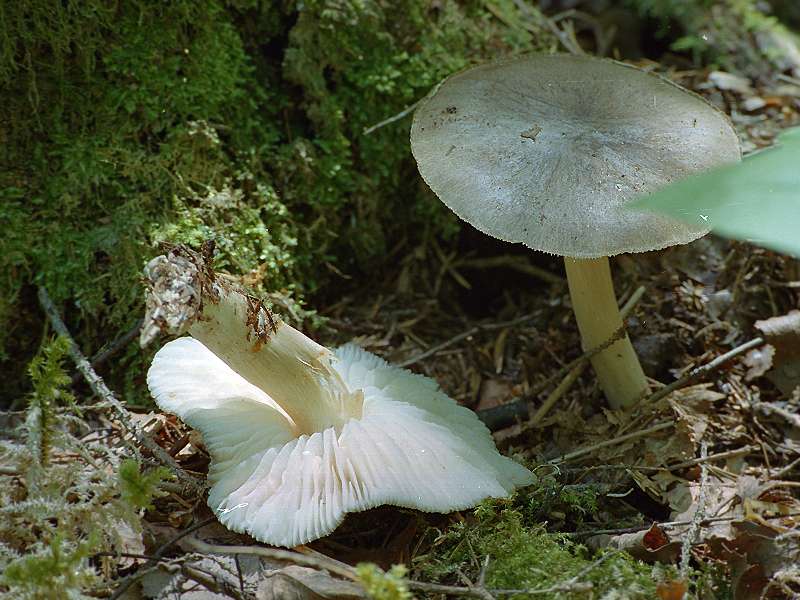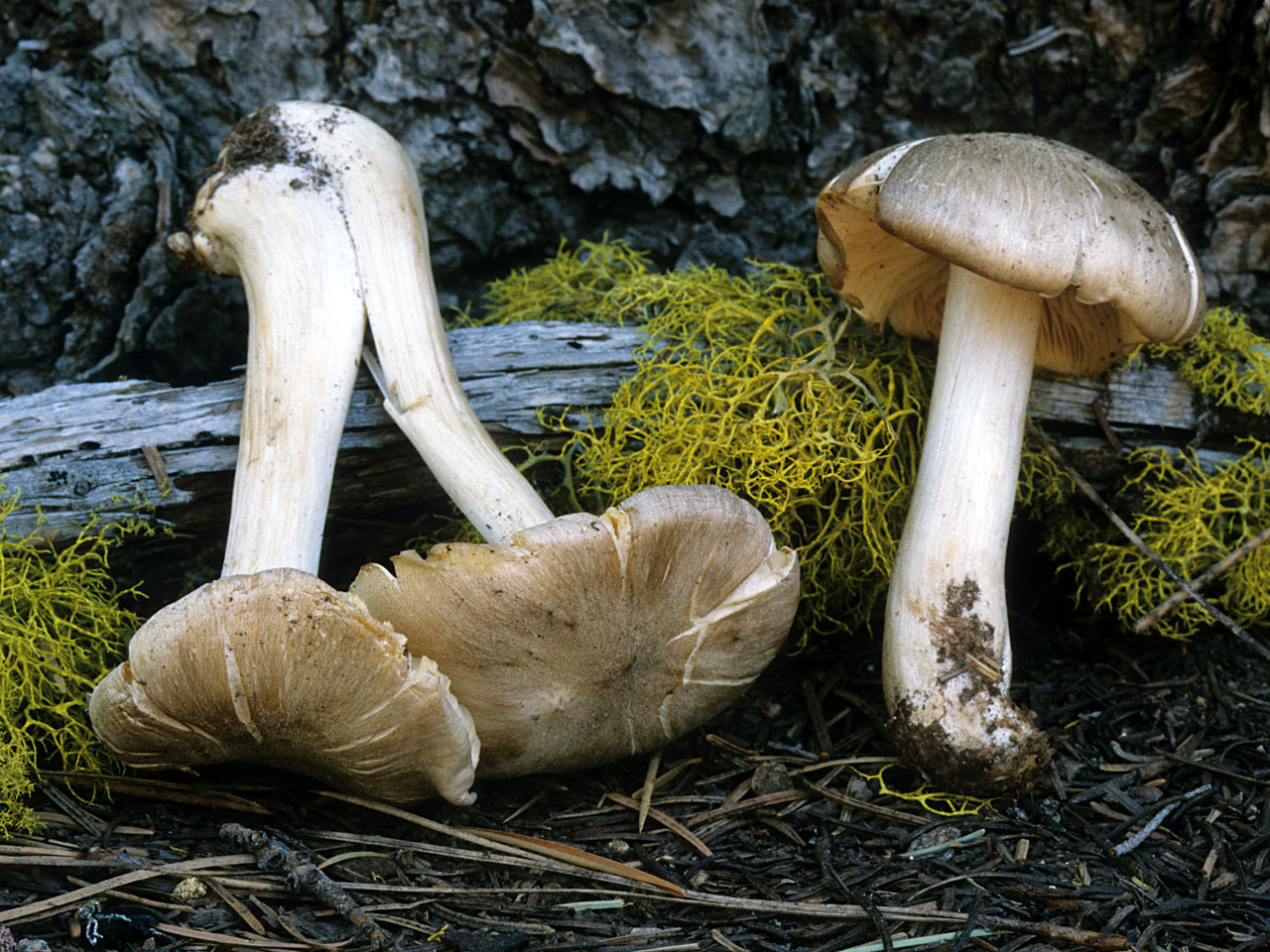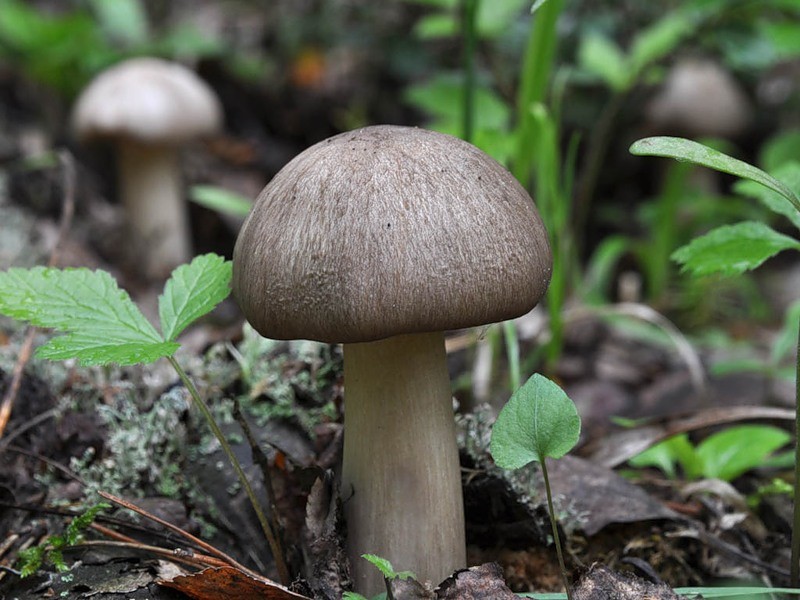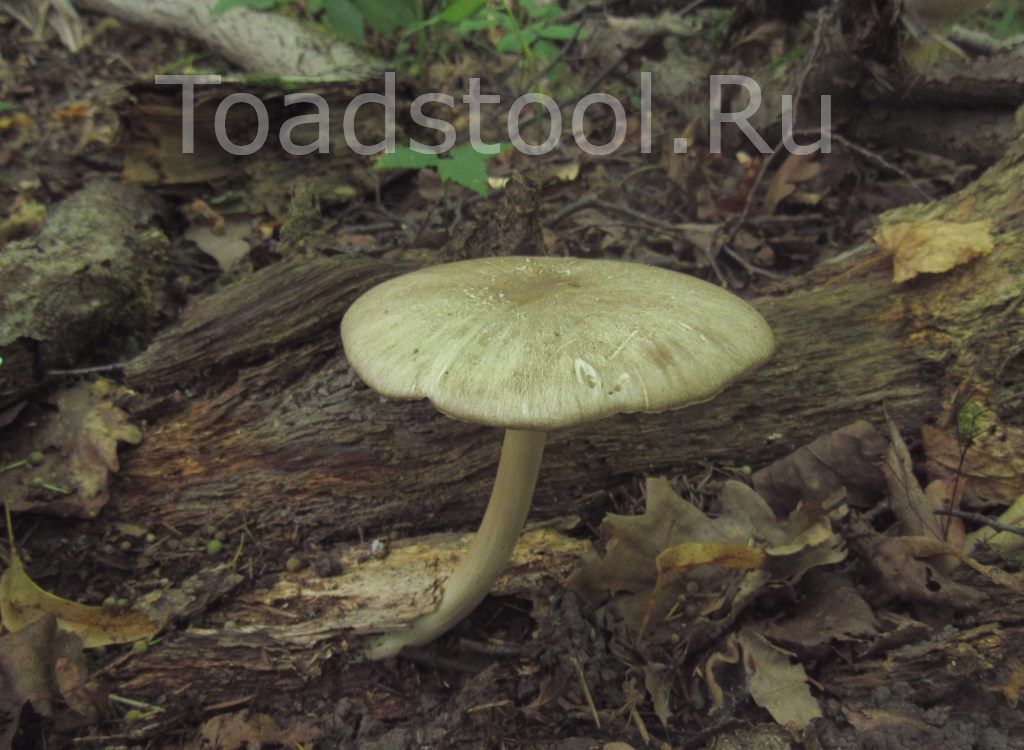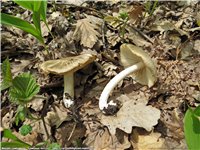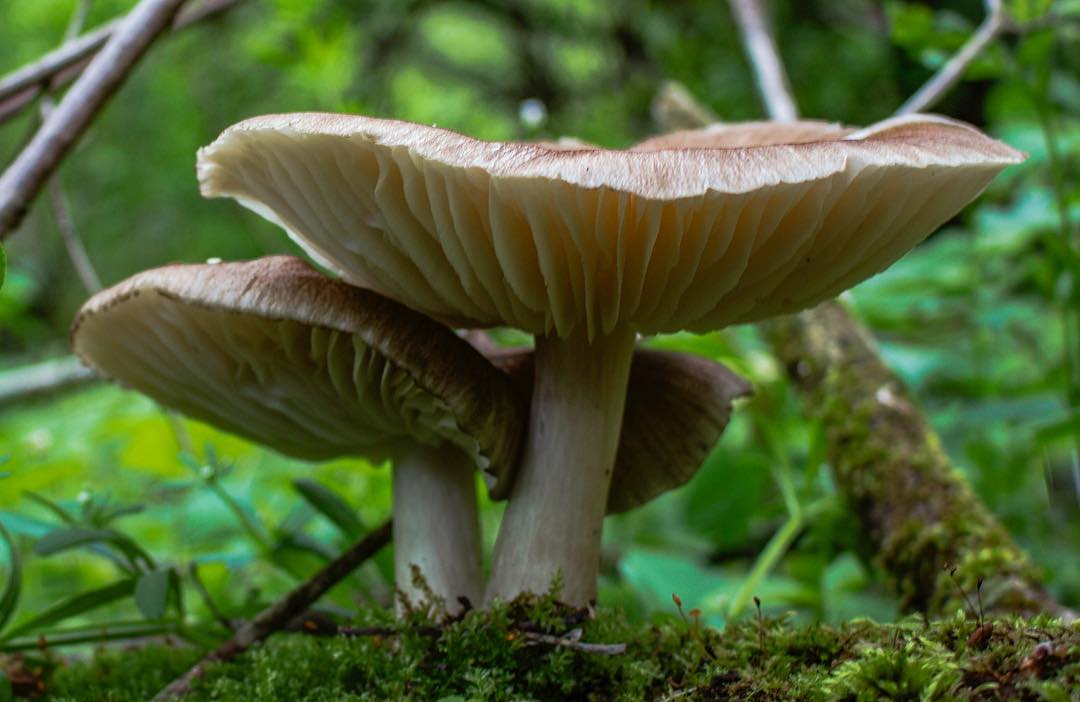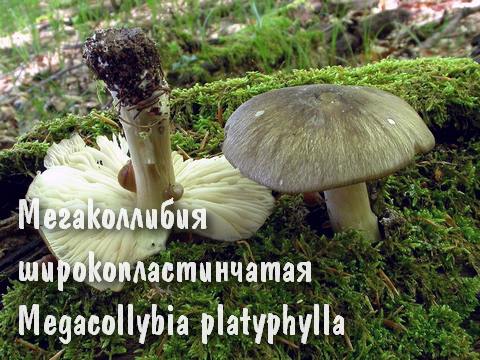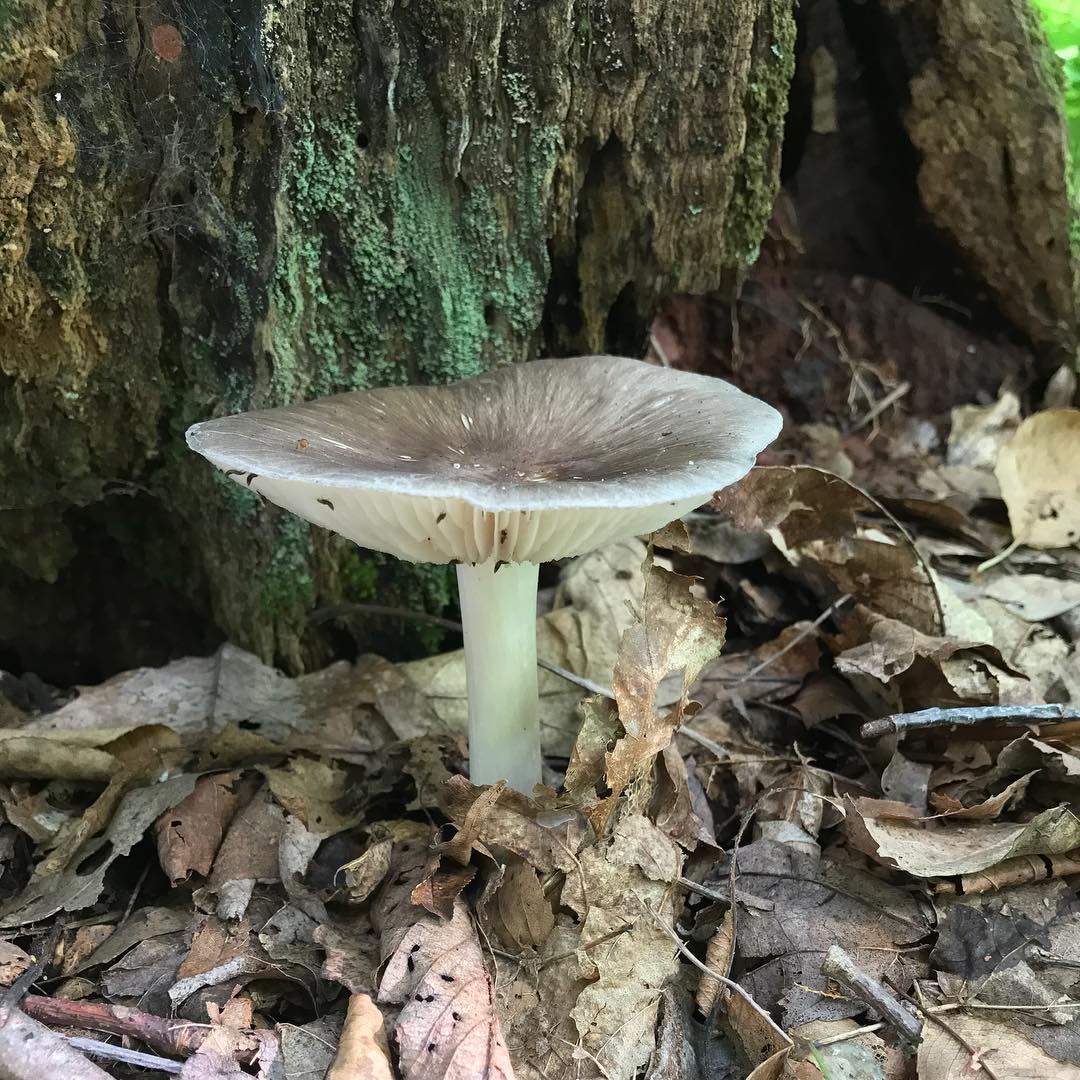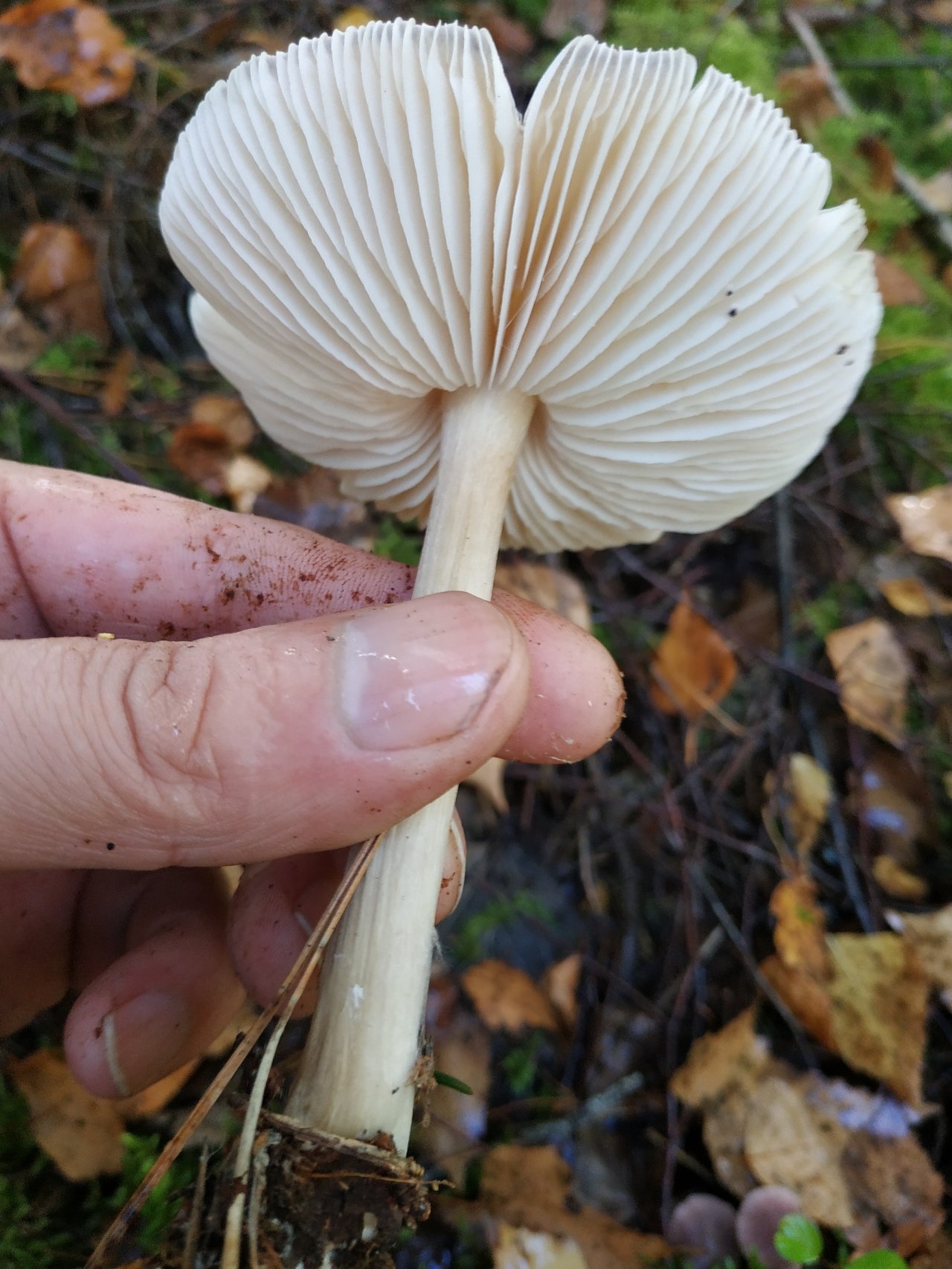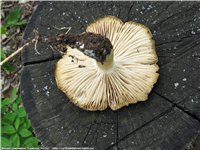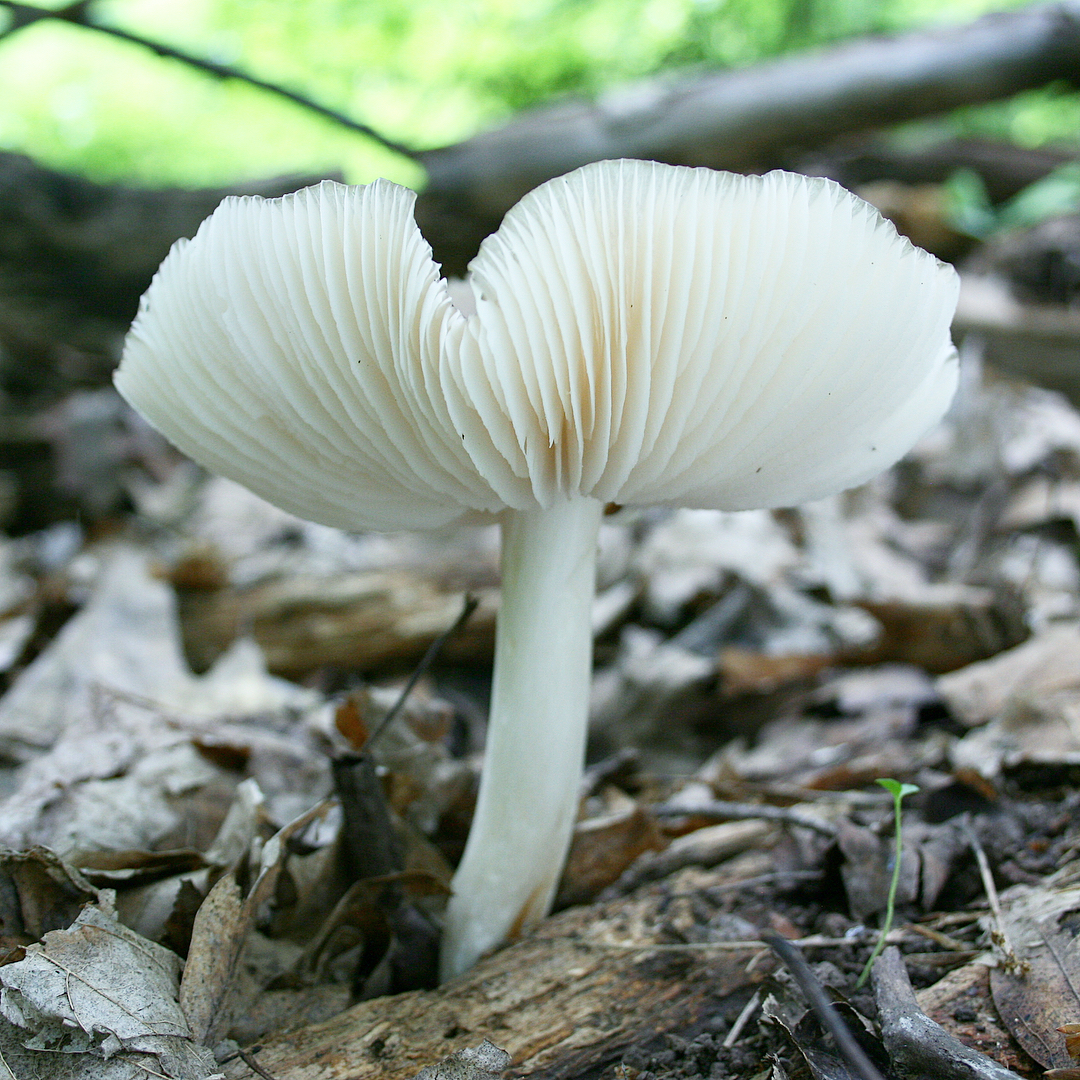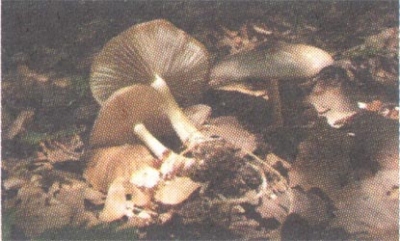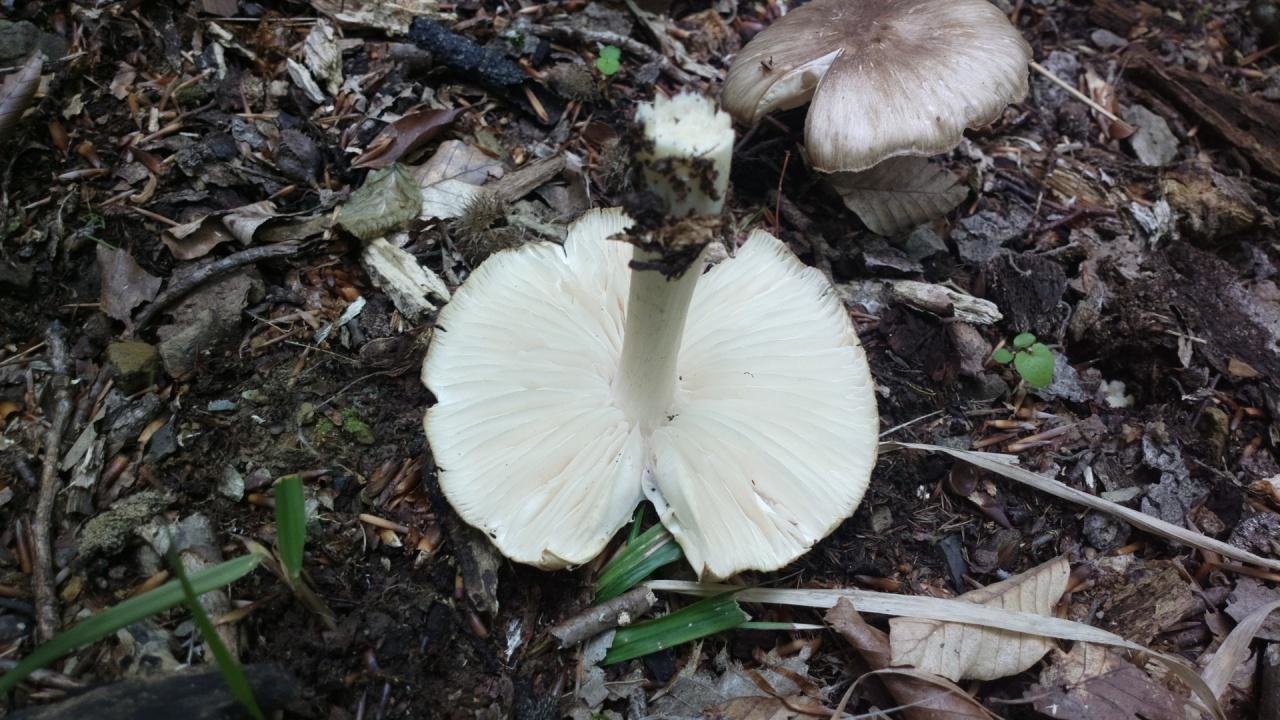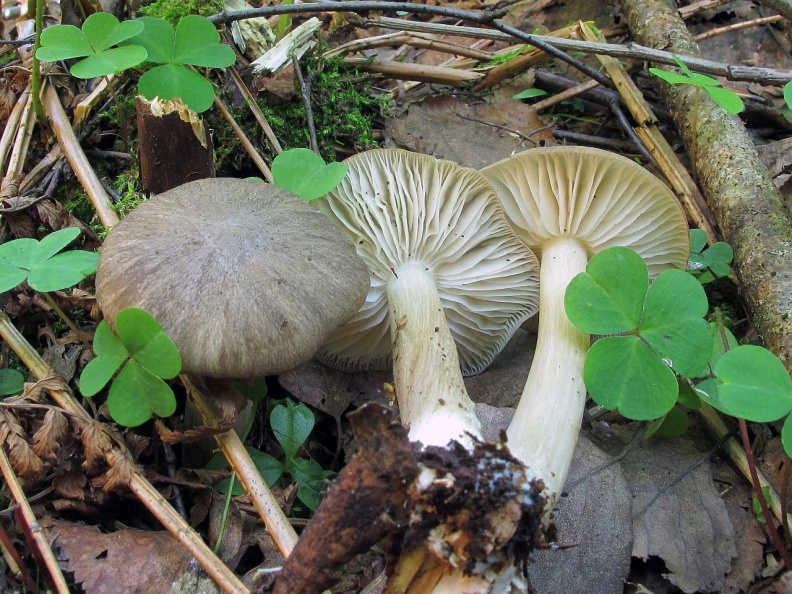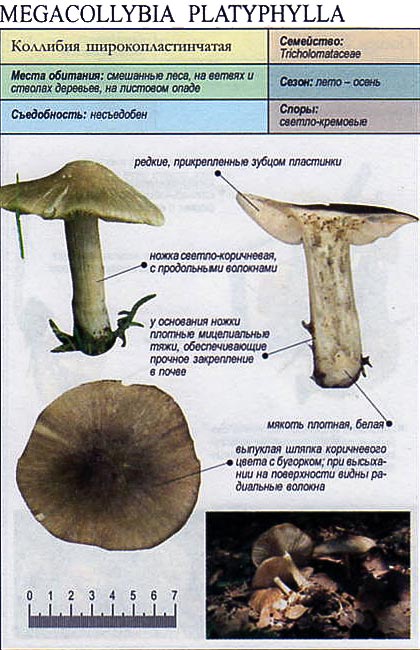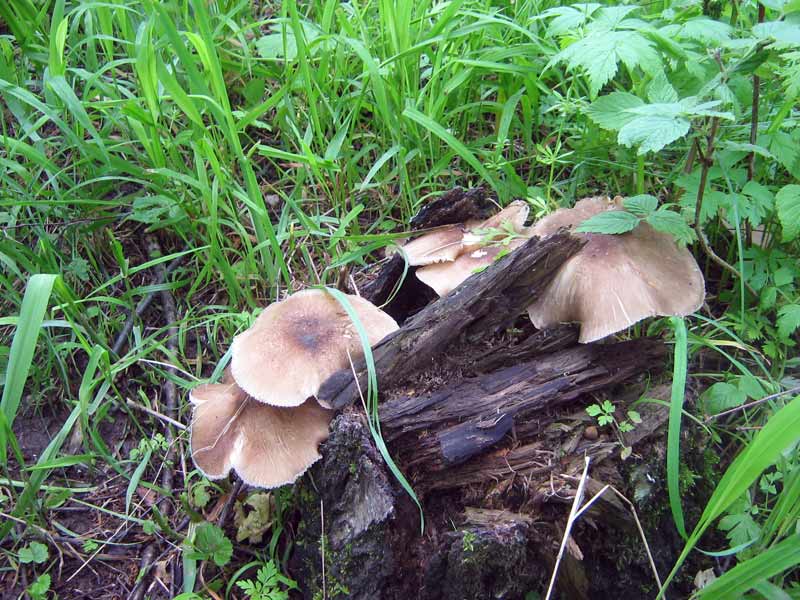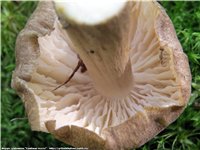Collibia oak-loving (Gymnopus dryophilus)
- Other names for the mushroom:
- Kollybia les-loving
- Spring honey
- Colibia Dubravnaya
- Regular money
- Wood-loving money
Synonyms:
Hat:
Diameter 2-6 cm, in youth hemispherical, with age gradually opens up to prostrate; plates often shine through the edges of the cap. The fabric is hygrophilous, the color changes depending on humidity: the color of the central zone varies from brown to light red, the outer zone is lighter (to waxy-whitish). The flesh of the cap is thin, whitish; the smell is weak, the taste is difficult to distinguish.
Plates:
Frequent, poorly adherent, thin, white or yellowish.
Spore powder:
White.
Leg:
Hollow, fibrous-cartilaginous, 2-6 cm in height, rather thin (the mushroom, as a rule, looks proportional), often pubescent at the base, with a cylindrical, slightly widening at the bottom; the color of the leg more or less corresponds to the color of the central part of the cap.
Spreading:
Collibia oak-loving grows from mid-May to late autumn in forests of various types - both on the litter and on the decaying remains of trees. In June-July, it is found in large numbers.
Similar species:
Mushroom Colibia oak-loving can be confused with meadow honey (Marasmius oreades) - much more frequent plates can serve as distinctive signs of colibia; in addition, there are several closely related species of colibia, which are relatively rare and, without a microscope, are completely indistinguishable from Collybia dryophila. Finally, this mushroom strikingly differs from light specimens of chestnut colibia (Rhodocollybia butyracea) by a cylindrical, not very thickened stem.
Edibility:
Various sources agree that the Colibia mushroom is oak-loving, in general, edible, but it makes no sense: there is little meat, there is no taste. However, no one forbids trying.
Notes:
The pseudo-popular name "money", supposedly referring to all small collisions, does not justify itself at all. For mushroom pickers, colibies are a kind of "backdrop" against which mushroom comedies and dramas are played; small colibies are an element of forest decoration, the same as last year's cones and night blindness flowers. What kind of "money" is there if you can't even count them!
However, some mushroom pickers still pay attention to the wood-loving colibia, strangely calling it "forest meadow honey." At the same time, explanations always follow in the sense that it makes no sense to collect forest meadow mushrooms, because there is neither taste nor smell in them
So, something has grown.
Spring honey mushroom (les-loving colibia), description of where it grows

Spring honey. Collybia oak-loving Collybia dryophila (Latin name). Belongs to the family Marasmiaceae. In former times, it belonged to the genus Collybia of the Tricholomataceae family. The genus includes about 70 species. People call this mushroom money. This mushroom is also called: forest-loving colibia. The mushroom is conditionally edible.
Where grow
Like other types of honey fungus, oak-loving kollibia prefers stumps. Usually, these mushrooms are collected in impassable places with spruces, aspens and old birches, in dry conditions. Columns of mushrooms are large in size.
Usually, spring honeydew is collected by those mushroom pickers who can distinguish it from its counterparts. Spring honeydew chooses deciduous and coniferous forests. This mushroom can be found in central Russia, in European forests, in the Far East and Siberia, in the Urals.
The mushroom ripens in early May and is harvested until October.
Description
The cap of this mushroom is small in size - 2-6 cm in diameter. The hat is smooth to the touch. The color is red or yellow-brown.First, young mushrooms have a convex cap shape, which becomes prostrate over time.
The plates are pale, faded, white and yellow. Frequent and adherent to the peduncle. Spore powder is white.
The stem of the mushroom is smooth, reddish brown. Light felt, stiff and fibrous near the base.
The pulp is pale in color, tender.
Beneficial featuresThe mushroom is not of high quality, but it is edible. Colibia oak-loving belongs to the 4th category.
You can fry, marinate in a mixture with other mushrooms. There are a large number of active elements in the mushrooms.
If you often eat these mushrooms, it will increase the body's resistance to infections, improve the functioning of the cardiovascular system. Also, these mushrooms have a positive effect on the gastrointestinal tract.
They have antioxidant, antiviral, immunostimulating, anti-inflammatory effects on humans.
CompositionIn mushrooms, there is a lot of fiber, proteins, carbohydrates. A large amount of vitamins (C and B1), copper and zinc, mineral elements.
If a mushroom picker has caught an inedible mushroom, then it is possible to distinguish it from an edible one, focusing on the unpleasant smell of sour, spoiled cabbage and on the pubescent leg of the twins.
Recipes
Certain types of honey mushrooms need to be cooked for a long time, as they are toxic. Usually mushrooms are cooked from half an hour to an hour, depending on their size. When the mushrooms boil, the water is drained and boiled in another water. It is better to boil it even earlier. Before eating this mushroom, you need to heat the product.
It usually takes half an hour to cook. Spring honey will go well with cereals, vegetables, pork, lamb, beef, poultry.
They are fried and stewed. Can be used alone or with other products. Young mushroom caps are best for pickling and pickling.
Vinegar works well as a flavor enhancer and as a preservative.
- Honey mushrooms with herbs and sour creamYou should take 500 grams of sour cream, 500 grams of honey mushrooms, 2 red onions, 1 bunch of dill, 50 grams of butter, black pepper and salt to taste. Frozen mushrooms are placed in a frying pan without defrosting. Fry until moisture evaporates. Peel and cut the onion and fry until soft in a hot skillet. Combine onions and mushrooms, add butter, heat, and then add pepper and salt. Place sour cream in a dish, let it boil, add dill. Remove from heat after a minute, mix all the ingredients and you can eat.
- Salting honey agaric
For salting, you need 500 gr. salt, ten kilograms of honey agarics, dill, 120 allspice peas, chopped onions, bay pepper. You can take mushrooms of different sizes. Rinse thoroughly, completely cut off the legs from large specimens. Cut the hats into pieces, place the pot with water on the stove, put 1 teaspoon of salt in 1 liter of water. Place the mushrooms inside after boiling water.
Cook for 20-25 minutes, then place in a colander until it cools down.In a bowl for salting, put bay leaf on the bottom, dill, chopped onion, pepper, and then a layer of honey agariches 5 cm thick. . mushrooms). After that, a layer of mushrooms and spices should be placed in the salting dish.
The mushrooms are covered with a cloth, and a lid and load must be placed on top.
Bring to readiness within 35-45 days in a dark place.
The article is here
Similar species
It bears great resemblance to colibia. The main differences are that in the colibia of the forest-loving plates of the spore-bearing layer are located much more often, in addition, meadow honey fungus prefers open spaces, while the colibia most often grows in forests.
Colibia chestnut
Conditionally edible. It differs in the color of the cap (for which it received its name) and the characteristic shape of the leg, which is thinning from the base to the upper part. This species, as a rule, is larger than its wood-loving “sister”, its cap is abundantly covered with a slimy-oily film, and the color of the spore powder is pink.
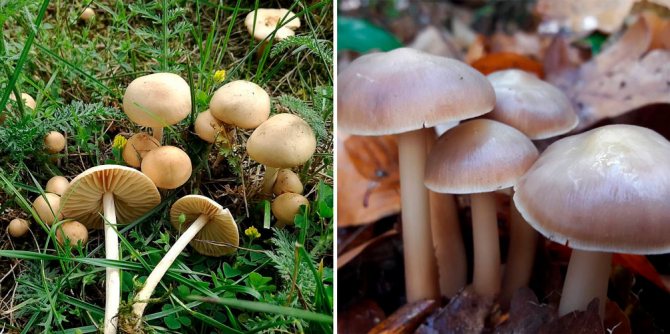
1- Meadow mildew 2- Chestnut colibia (oil)
Many closely related species of the genus colibia are indistinguishable from wood-loving colibia with the naked eye; only a microscope can give an accurate definition. Among them there are poisonous species, which, fortunately, are extremely rare in the forests of our country.
House mushroom (Serpula lacrymans)
Hide ads in article
HOUSE MUSHROOM (Serpula lacrymans)
the most harmful of all the mushroom houses and the most common in the territory of the former USSR. It is found from the Baltics to Kamchatka, and is known in Western Europe and North America.
A real mushroom house is one of those few types of mushrooms that are found only in buildings and are not observed in nature. The fungus infects mainly the wooden parts of the lower floor and basement: floors, walls up to a height of about 1 m. The first signs of infection are a musty odor in the premises, non-drying, wet spots on the wall, and then loose floor boards. When opening the floor, you can find cotton-like accumulations of fungal mycelium, mushroom strings and films. At first they are white, and then with a characteristic yellowish, pinkish, lilac and gray tint. Some of the wood has already completely rotted, some have turned brown and become soft.
Rot spreads very quickly in wood; this is facilitated by the growth of mushroom laces and films on the surface of infected wood. It takes up to a year, and sometimes even six months, to completely decay a floor or a beam. On the lower surface of rotten wood, fleshy-scarious fruit bodies are formed, which can reach significant sizes, up to several meters long. In damp rooms, fruit bodies also appear in the lower part of the walls inside the room, at the base of jambs, etc. The presence of such fruit bodies visible inside the room itself is a sign of widespread and severe damage to wooden structures.
On the fruit bodies, basidiospores of the fungus are formed in mass quantities, which are sometimes visible as brown dust on the floor or in the corners of the room. On 1 cm2 of the surface of the fruiting body, up to 35 million spores can be released during the day; the most intense sporulation in spring and in the first half of summer.
Spores of a real house mushroom are very light. In 1 m3 of air in a contaminated room, there are up to 2.5 million spores. They are carried even by small air movements; in the air of any city or village, there are almost always spores of a real house mushroom. Spores can be accidentally transferred to people's shoes and clothing. Especially dangerous are boards infected with the fungus and other rotten wood residues, which, during repairs, are often thrown into the yard or even brought as fuel to uninfected houses.
For germination and further infection of wood, spores require certain conditions. This is primarily the high moisture content of wood and ambient air. The most intense decay is observed at an air humidity of 90–95% and a temperature of 18–23 ° C. Such conditions can arise with improper construction of a building, when the insulation of wooden structures from the foundation is not well laid. The accumulation of condensation moisture is often observed, for example near water pipes; rain or melt water getting into basements, under walls. Many simple wooden buildings in Siberia and in the north of the Far East are built with a plinth, which serves to insulate the lower part of the building. If water (rain) gets into the filler of the basement, then infection with house mushrooms is almost inevitable.
The second group of causes of infection is negligence in the operation of houses. Untimely roof repairs, faulty ventilation in damp rooms, leaking water pipes and other shortcomings in maintenance will lead to a constant accumulation of dampness and, at the same time, conditions are created that are favorable for the development of house mushrooms. If buildings are infected with a mushroom house, urgent repairs are needed. Being late for repairs, even only for a month or two, can increase losses several times.
When repairing, wooden structures contaminated with fungus should be completely removed. The initial stage of the development of rot is invisible to the naked eye, therefore, it is necessary to remove apparently healthy boards bordering on clearly rotten ones: along the grain of the wood up to 0.5 m, and across the fibers at least 20 cm. The top layer under the infected floor must also be carefully removed: mushroom can persist for a long time and develop in the form of mycelium in wet soil or even in sand, if there is an admixture of sawdust or humus.
Infected constructions should be replaced with new ones made of dry antiseptic wood or rotting material. The new floor must not be immediately covered with a dense covering (linoleum, relin and other synthetic materials), which prevents the floor from drying. But the main thing during repairs is to find and eliminate the reasons that favored the development of the house fungus, creating the conditions necessary for its development (dampness, accumulation of moisture).
Lesbian Collibia (Gymnopus dryophilus)
- Other names for the mushroom:
- Spring honey
- Collybia is dubious
- Colibia Dubravnaya
- Regular money
- Wood-loving money
Synonyms:
Hat:
Diameter 2-6 cm, in youth hemispherical, with age gradually opens up to prostrate; plates often shine through the edges of the cap. The fabric is hygrophilous, the color changes depending on humidity: the color of the central zone varies from brown to light red, the outer zone is lighter (to waxy-whitish). The flesh of the cap is thin, whitish; the smell is weak, the taste is difficult to distinguish.
Plates:
Frequent, poorly adherent, thin, white or yellowish.
Spore powder:
White.
Leg:
Hollow, fibrous-cartilaginous, 2-6 cm in height, rather thin (the mushroom, as a rule, looks proportional), often pubescent at the base, with a cylindrical, slightly widening at the bottom; the color of the leg more or less corresponds to the color of the central part of the cap.
Spreading:
Wood-loving collibia grows from mid-May to late autumn in forests of various types - both on the litter and on the decaying remains of trees. In June-July, it is found in large numbers.
Similar species:
The forest-loving Colibia mushroom can be confused with the meadow honey (Marasmius oreades) - much more frequent plates can serve as distinctive signs of colibia; in addition, there are several closely related species of colibia, which are relatively rare and, without a microscope, are completely indistinguishable from Collybia dryophila. Finally, this mushroom strikingly differs from light specimens of chestnut colibia (Rhodocollybia butyracea) by a cylindrical, not very thickened stem.
Edibility:
Various sources agree that the forest-loving Collibia mushroom, in general, is edible, but it makes no sense: there is little meat, there is no taste. However, no one forbids trying.
Notes:
The pseudo-popular name "money", supposedly referring to all small collisions, does not justify itself at all. For mushroom pickers, colibies are a kind of "backdrop" against which mushroom comedies and dramas are played; small colibies are an element of forest decoration, the same as last year's cones and night blindness flowers. What kind of "money" is there if you can't even count them!
However, some mushroom pickers still pay attention to the wood-loving colibia, strangely calling it "forest meadow honey." At the same time, explanations always follow in the sense that it makes no sense to collect forest meadow mushrooms, because there is neither taste nor smell in them
So, something has grown.
Collibia les-loving - description, where it grows, the poisonousness of the mushroom
According to the variety of mushrooms, the wood-loving colibia is classified as a non-nylon mushroom family. The people call this variety of mushrooms the spring mushroom for its external resemblance to mushrooms. However, such confusion often occurs due to the mistake and inexperience of the mushroom pickers themselves. In fact, colibia is considered a parasitic fungus and has nothing to do with mushrooms.
According to the edibility classification, the representative of the mushroom kingdom, the colibia, is usually classified as conditionally edible mushrooms of the fourth category. After the collibia is in the mushroom picker basket, it should be cooked. The mushroom must first be boiled and the resulting broth drained, only after that it can be used for food.
Characteristics of the forest-loving colibia
Young colibia mushrooms have a cap that looks like a sphere. As the mushroom develops, its cap takes on a spread, flat shape with transparent margins. The diameter of the mushroom cap reaches about 2-6 cm. Young colibia fungi have some similarity with apples that fell on fallen leaves in the forest.
The core of the mushroom has brown, light yellow or sometimes white flesh. The color of the pulp directly depends on the conditions and environment in which the mushroom matures. If you look through the thin and transparent edges of the cap, you can see the plates that are weakly attached to the base of the mushroom. The older the mushroom ripens, the more it will become covered with reddish spots that appear on the inside of the fruit. The transparent and thin edges start to tear.
The mushroom leg has a thin base, it is hollow inside and twists slightly along its length, at the end it thickens a little. The structure of the stem of the fungus has a fibrous and cartilaginous surface. The cap and leg are the same color. The mushroom leg can be up to 2 or 6 cm in length.
Is the les-loving kollibia edible?
Colibia is an edible mushroom, so it can be used in recipes. However, due to its low taste, it is not in great demand among mushroom pickers. In addition, if a person has disorders associated with digestive problems, then you should not use this mushroom for food. Colibia can cause intestinal and stomach ailments and painful sensations.
Collibia is also not very popular among chefs, as there is very little soft core and pulp inside the mushroom for cooking. In addition, the mushroom does not have a strong aroma and taste. The aroma of colibia can even, on the contrary, give dishes an unpleasant smell with an admixture of mold and rot.
Growing environment of colibia
The habitat of the fungus is considered to be the forest, which is why the colibia is called wood-loving. You will not find it in fields or gardens. Colibia can be found in the deciduous and coniferous thickets of the forest. This type of mushroom family grows most often in the European part of Russia.
The first mushrooms germinate in May and give inputs until the end of autumn. Colibia can be found among foliage, in a damp lowland, in a rotting fallen tree or on a stump, thanks to which the fungus survives and receives the substances and water it needs. Also, the fungus can grow on the surface of the tree trunk.
Doubles in the kingdom of mushrooms
There are wood-loving kollibia and close relatives. Colibia is considered such a relative of the fungus, it also belongs to the conditionally edible varieties of mushrooms. The mushroom is brown or red-brown in color. Also, wood-loving kollibia can often be confused with some other species of the kolibia family, which, moreover, can be very poisonous and life-threatening. However, poisonous varieties are rare. Only experienced mushroom pickers can find the difference between a poisonous and an edible mushroom.
Collibia broad-lamellar, Megacollybia platyphylla

Hat: Diameter 5-15 cm (from compact to very large), bell-shaped in youth, then gently unfolds, keeping a blunt tubercle in the center. In old age, the edges of the cap may bend upward. The structure is radial-fibrous (which in dry weather often leads to the fact that the edges begin to crack and shaggy), the color is from moderate gray to brown. The pulp is thin, white, with a weak mushroom odor and a bitter taste.
Blades: Relatively sparse, wide, adherent with a tooth.The color is white, only in extreme old age the discs acquire some kind of "dirty" shade.
Spore powder: White.
Leg: Geometrical dimensions vary within a very wide range - height from 5 to 15 cm, thickness - from 0.5 to 2-3 cm. The shape is predominantly regular, cylindrical, widened at the base. Color - from light gray to brown, longitudinal fibrous surface. In young mushrooms, the stem, as a rule, is whole, with age it becomes complete. A characteristic distinguishing feature is the powerful white cords-rhizoids, with which the mushroom is attached to the substrate.
Distribution: Begins to bear fruit at the end of May and comes across until the end of September, and, judging by practice, it is the first, spring layer that is the most abundant. It grows on pretty decayed stumps of deciduous trees, as well as on forest litter. According to unverified data, it forms two stable forms - "pneumo" (brown compact mushrooms) and "soil" - light gray fruiting bodies, thin and very tall. Perhaps all this is one big mistake, and we must talk about two completely different types.
Similar species: Sometimes the deer whip, Pluteus cervinus, which is easily distinguished by its frequent pinkish plates, a stem with gray scales, and the absence of noticeable cords at the base, is sometimes confused with the wide-lamellar collibia. Again, the question of the two varieties of Megacollybia platyphylla is not entirely clear to me. However, in the context of “similar species” it is hardly appropriate to talk about this: they are completely different from each other.
Edible: It hardly makes sense to talk about it.
Author's notes: I have a lot of comments about this mushroom. The first acquaintance turned out to be simply disgusting: I plucked a mushroom found in the park, put it on a piece of paper under a cup for scientific purposes, and forgot about it for about a day. The result was discouraging: a day later, a wiggling clot of worms was found under the cup, forming a shape resembling a mushroom cap. In general, somehow it didn't work out right away with him.
Now it is necessary to admit that wide-lamellar collibia worries me in earnest. I cannot accept that a small dense mushroom growing on a stump with a brown cap and a powerful fibrous stalk belongs to the same species as the subtile whitish toadstools that peep out of young grass in the spring. Anything but this. Although there seems to be no way out: the experience of my colleagues convinces me that it is necessary to come to terms with this knowledge and even learn to live somehow.
Kollybia les-loving
Family: Ordinary (Tricholomataceae).
Synonyms: wood-loving money, oak-loving money, spring honey, forest meadow honey.
Description. The forest-loving colibia fungus is very diverse in color and size, and its color can vary from almost white to black-brown.
The range of the cap is inconsistent (it may be darker in the center and lighter at the edges and vice versa), brown-ocher, reddish, yellow-brownish, sometimes with a reddish tint, pale ocher. Transparent stripes along the edge of the cap are sometimes pronounced, sometimes not very. When dry, the cap becomes discolored.
Frequent and thin blades can be white, yellowish, clayey. It takes several years to get used to the spring forest in order to learn to recognize it in all guises.
In part, the wood-loving money resembles a meadow honey fungus, differing from it primarily in a hollow leg with a brown or rusty tint inside. The cap is 3-8 cm in diameter, at first hemispherical or convex with a drooping edge, then convex-outstretched, prostrate, sometimes with a drooping or wavy edge, slightly depressed.
The pulp is thin, whitish, dense in the stem, with a weak mushroom odor. Stem 3-8 X 0.2-0.5 cm, smooth, hollow, more or less monochromatic with a cap, reddish or brownish at the base, pubescent.
It is found throughout the temperate zone of Russia in forests of various types. The forest-loving colibia fungus grows on litter and rotten wood, often covering deadwood and old stumps with a continuous carpet.Fruiting from late April to early November.
Similar species. It differs from meadow mushroom (Marasmius oreades) primarily in more frequent blades and the absence of a tubercle on the cap. Collibia chestnut (C. butyracea) is distinguished by more fleshy fruiting bodies, a clearly widened leg at the base and always a brown cap to one degree or another.
Medicinal properties: β-glucans, which have strong anti-inflammatory activity, have been isolated from the fruit bodies.
In addition, CDP induces a significant increase in prostaglandin E2 production in macrophages.
Culinary Uses: Lesser Colibia is a good edible mushroom of small size, used fresh and for drying.
Despite the mineral poverty of cucumbers, their useful properties are quite high. These fruits saturate cells with moisture, promote the elimination of fluid from the body and ...
Read completely "
As an auxiliary treatment for stomach and duodenal ulcers, folk remedies are often used: herbal preparations and phytoapplications. Also in therapeutic ...
Read completely "
Read more »Treatment of diseases, Phytotherapy
Raw raspberries are a storehouse of medicinal substances, so its use in the treatment of various diseases is quite justified. Folk remedies using raspberries are recommended ...
Read completely "
It turns out that the fruit stalks have no less useful properties than the berries themselves. For example, strawberry stalks are beneficial for gout, skin problems, and gastrointestinal disorders. And medicinal ...
Read completely "
Pumpkin seeds are not only a tasty "snack", but also a raw material for the manufacture of drugs for pharmacological and cosmetological action. Pumpkin seeds are used ...
Read completely "
Read completely "
The use of viburnum seeds in folk medicine and cosmetology is quite widespread. It is recommended to use viburnum seeds as a remedy for colitis, ...
Read completely "
Like grape seeds, apricot seeds have useful properties, therefore they are actively used in folk medicine and cosmetology. From the kernels of apricot kernels ...
Read completely "
Treatment with grape seeds has been practiced since ancient times: thanks to the presence of resveratrol and the flavonoids of proanthocyanides, grape seeds contribute to better assimilation ...
Read completely "



